Jacob Lawrence American, 1917-2000
76.2 x 63.5 cm
"Moving Day" is among Lawrence’s first great works. It hung in an important group exhibition at the Harlem Community Art Center in 1938, where Lawrence was in the fine company of Norman Lewis, William Johnson, and others. When he showed it in 1939, in his fifth exhibition ever (he had only had two previous solo exhibitions, and the 1939 show at the American Artists School paired the young Lawrence with Samuel Wechlser). ARTnews reviewed the show:
"A fresh, vivid view of Negro life in New York may be seen in the tempera paintings of Jacob Lawrence, a graduate of the American Artists School where an exhibition of his work is now being held. A style which it is easy to call primitive marks his versions of ice peddlers, the subway, the park and restaurants, but closer inspection reveals draughtsmanship too accomplished to be called naïve. The bright colors in flat areas and the literal view of the world turn out to be just his manner of expressing his very sensitive reactions to a kaleidoscopic, animated world, in which his spirit is not to be downed by the oppression and neglect of his own people which he sees on all sides. They have little of the mournfulness of spirituals. Rather are they testimony of the unquenchable joie de vivre of the Negro, his inestimable gift to repressed, gloomy Nordics" (Jeannette Lowe, “The Negro Sympathetically Rendered by Lawrence; Wechsler,” ARTnews, February 18, 1939).
The dated demonyms aside, the review ages well: Lawrence did not flinch from grim realities, but rendered his scenes with dignity, vitality, and “unquenchable joie de vivre.” "Moving Day" is a masterpiece in this regard. Rather than depict the inward life of home and hearth, Lawrence focused on the bustle of life out in the Harlem streets. The movers are the tenants themselves, carrying their possessions. With neither time to pack nor money to hire help, the family makes do, everyone carrying something: mother carries brooms and books, while the children carry chairs, and smaller children. It is a portrait of necessity as the mother of invention, a family triumphing over life’s little adversities rather than being crushed by them.
When the work was shown at the Katonah Museum of Art, (Jacob Lawrence - The Early Decades, 1935-1950, 1992), The New York Times observed:
"It was the beginning of the end of the Harlem Renaissance, but still vibrant with black artists, writers, musicians, and performers of world-wide renown. The homely scenes of daily life he depicted were imbued with dignity and timelessness by his use of a modified form of cubism and bold, flat coloring" (The New York Times, “Jacob Lawrence’s Art,” March 1, 1992, p. 530).
Lawrence’s place in the Harlem Renaissance is well described here: while his career began too late for the roaring twenties, it is just as well. The very migration that fueled the flowering of African American intellectual life in the 1920s became Lawrence’s greatest subject, which he chronicled in "The Great Migration" series, now in the collection of the Phillips Collection, Washington, D.C., and the Museum of Modern Art, New York.
"Moving Day" stands apart, a template for all that would come in Lawrence’s career. It is sure-footed in its modernist techniques, flatting planes, distorting scale, and heightening color. And it does so well what Lawrence contemplated his whole life: finding celebration amid suffering, and life where others fail to look.
Provenance
Jacob and Gwendolyn Knight Lawrence, New York and Seattle; to
[Washburn Gallery, New York]; to
Leah Salisbury, New York, c. 1950; <-- NOTE: AS REPORTED BY CATALOGUE RAISONNE, BUT THIS CAN'T BE RIGHT: WASHBURN OPENED IN 1971 ]
By descent to private collection, New York; to
Private collection, New York, until the present
Exhibitions
Harlem Community Art Center, New York, Paintings and Sculpture by 21 New York City Negro Artists, February 4-March 4, 1938 // American Artists School, New York, Jacob Lawrence and Samuel Wechsler, February 1939, no. 18 // Katonah Museum of Art, New York, Jacob Lawrence, The Early Decades, 1935-1950, March 1-April 19, 1992 // DC Moore Gallery, New York, Jacob Lawrence: Moving Forward, Paintings 1936-1999, February 13-March 22, 2008, pp. 9, 17, 76, illus. (as Moving Day a.k.a. Disposessed)
Literature
Peter T. Nesbitt and Michelle DuBois, Jacob Lawrence: Paintings, Drawings, and Murals (1935-1999), A Catalogue Raisonné, Seattle, Washington, 2000, p. 24, no. P37-09, illus. // Peter T. Nesbitt and Michelle DuBois, Over the Line: The Art and Life of Jacob Lawrence, Seattle, Washington, 2000, p. 17, pl. 4, illus. // Patricia Hills, Painting Harlem Modern: The Art of Jacob Lawrence, Berkeley and Los Angeles, California, 2009, pp. 32, 36, 291, no. 28, illus.
Subscribe to our mailing list to receive updates from the gallery
* denotes required fields
We will process the personal data you have supplied in accordance with our privacy policy (available on request). You can unsubscribe or change your preferences at any time by clicking the link in our emails.

